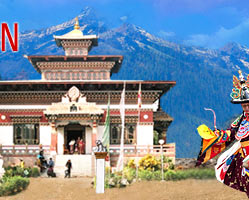- Humid and subtropical climate in the foothills and plains in extreme south,
- Temperate climatic conditions in Himalayan valleys to the north of the plains and central regions of Bhutan, and
- Extreme cold climatic conditions in the north of Bhutan where there is snow and ice all the year round, on the high mountain peaks and main Himalayan summits.
Bhutan receives heavy monsoon rainfalls, like most of the South Asian countries but it is the western region that receives most of the rainfall that ranges from 60 to 90 percent of the region's total rainfall. Annual precipitation in the north is restricted to about 40 mm and that too in the form of snow, because of the extreme climatic conditions there but an average of 1000 mm of annual precipitation is common in central Bhutan with temperate climatic conditions. In the hot and humid subtropical climate of southern Bhutan, the average annual precipitation at certain places has been as high as 7800 mm. Thus, thick tropical forests known as Savanna are found in southern region of Bhutan. Winters are dry at Thimphu and there is almost no precipitation until March and rainfall average for a month is not more than 20 mm. However, the reason receives total annual rainfall of about 650 mm, with the maximum rainfall in August, when there is about 220 mm of rainfall.
Spring in Bhutan lasts from early March to mid-April and is mostly dry. Summer starts in mid-April and brings occasional showers with it and lasts through late June with intermittent pre-monsoon rains. Summer monsoon lasts from late June to late September and is characterized by heavy rains resulting from the southwest winds moving northwards and blocked by Himalayas. The monsoon days normally have high humidity and are misty and overcast with rain-bearing clouds. Flash floods and landslides are common. Autumn succeeds the monsoons and lasts from late September or early October to late November, characterized by bright, sunny days. There can be some snowfall at higher elevations though. Winter sets in late November and lasts till March. Frosty days characterize winters of Bhutan. Snowfalls are common is places above 3000 m elevation. Northeast winds bring winter monsoons and it is these gales and winds, rushing with force through High Mountain passes, that earns Bhutan the name of ‘Drukyul’ or the ‘Land of the Thunder Dragon’.




